 |
|

|
 |
TABLE of CONTENTS
 |
Bonding bill approved in special legislative session |
By Rich Kemp
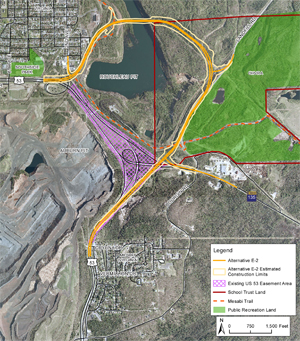
The Hwy 53 relocation project received $140 million dollars from the Legislature during the special session. The project will move the highway off ore deposits. |
After the Minnesota State Legislature finished its work with a two-day special legislative session, Gov. Mark Dayton signed several bills into law June 12, including a bonding bill. The bill passed 96-25 in the House and 48-18 in the Senate.
The bonding bill includes $140 million to complete the relocation of Hwy 53 near Virginia. MnDOT is on a tight deadline for moving the highway off ore deposits. Under an agreement signed during the 1960s, the current mining companies notified MnDOT that it will terminate an easement the State has for a portion Hwy 53. The agency has to move the highway by spring 2017.
Along with $140 million in trunk highway bonds, the bill contained the following transportation-related provisions:
- $7.4 million for local bridges
- $4.29 million for local roads
- $850,000 for local road-Sandstone
- $3.77 million for Willmar Wye project
- $1 million for Minnesota Valley Regional Rail
- $4.7 million for Plymouth-Vicksburg Lane Rail crossing
- $460,000 for Rainy River Rail crossing
- $10 million for Richfield-77th St. underpass
The special session also passed provisions related to local governments, including;
- Allowing the city of Little Canada to use existing funds for railroad signage
- Allowing the city of Virginia use of existing funds for utility relocation due to the Hwy 53 project
- Providing funding for local road and bridge replacement due to 2014 flooding
Because of the State Capitol renovation, the special session was held in the State Office Building with related activity in the Transportation Building. The news media occupied two conference rooms and while the public had access to watch the House and Senate floor proceedings via televisions set up in the cafeteria.
For more information, check out the Bonding Bill Fact Sheet or a statewide map of projects in the bonding bill.
|
 |
|

|
 |
TABLE of CONTENTS
 |
Minnesota debuts radar detector for crash detection |
By Shannon Fiecke
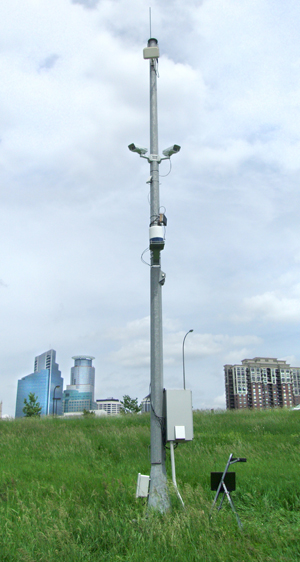
A radar system is gathering real-time traffic data on Interstate 94, which will be compared with traffic incident records from MnDOT’s Regional Transportation Management Center. Photo courtesy of the Office of Traffic, Safety and Technology |
A technology used in Europe for airport security and freeway crash detection will be put to the test this summer on Minnesota’s most crash-prone stretch of highway.
The U.S. Federal Communications Commission recently gave MnDOT the green light to deploy a long-range radar detection system on westbound Interstate 94, east of the Lowry Hill Tunnel, near the I-35W overpass in Minneapolis.
Minnesota will be the first state in the country to test the system, which is capable of detecting crashes and stalled traffic in all weather and light conditions, including variations near tunnels and snow, ice, fog and smoke.
The detector, which scans up to 500 meters in each direction, is designed to spot pedestrians, slow-moving or reversing cars, and roadway debris. It performs a radar scan of all objects within a 360-degree radius of the unit, four times per second.
If the radar detector is successful at quickly detecting incidents, MnDOT and the State Patrol will be alerted of an incident sooner allowing for a faster response by emergency crews. Faster response and removal of incidents on the freeway can result in a reduction of incident-related congestion and reduce the potential of secondary crashes.
“If the radar detection system is successful, we may purchase the technology for other high-volume, high-crash locations or road shoulders where vehicular traffic is allowed during peak hours,” said Brian Kary, Freeway Operations engineer.
For the next six months, the project team will collect traffic data using the 360 Degree Radar Information System. They will compare the information with traffic incident reports and highway video to determine how effective and fast the system is at detecting roadway incidents near the Lowry Hill Tunnel.
The consulting firm, AECOM, pitched the idea for the radar system to MnDOT’s ITS Innovate Idea Program, which allows private businesses or public partners to propose new ideas and demonstrate advancements in technology that address transportation challenges in Minnesota.
AECOM partnered with RhiZone and Navtech Radar to test the system in an operational setting and will continue working with Rashmi Brewer, MnDOT’s ITS project manager. The technology is one of many products piloted over the years by the Office of Traffic, Safety and Technology, some with success, and all providing useful information.
“We’re always testing new products in order to discover new tools that can help us to do our job more efficiently and effectively,” Kary said.
|
 |
|

|
 |
TABLE of CONTENTS
 |
Modes Moving Minnesota effort connects agency work |
|
By Marcia Lochner, Office of Freight & Commercial Vehicle Operations
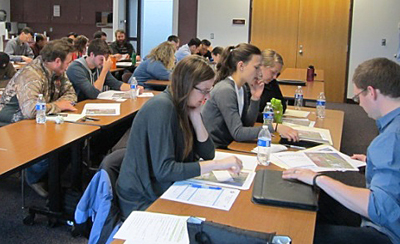
MnDOT graduate engineers participate in a Modes Moving Minnesota activity May 13 in Duluth. Photo by Erik Baxstrom |
A team of five MnDOT staff gathered in Duluth May 13 to kick off Modes Moving Minnesota, a communications and information effort to educate, in this instance, graduate engineers about how the agency’s work is planned, programmed and funded in support of the transportation modes.
Panelists representing the modal offices were Ryan Gaug, Aeronautics; Maureen Jensen, Freight and Commercial Vehicle Operations; Frank Loetterle, Passenger Rail; Mike Schadauer, Transit; and Mark Nelson, Transportation System Management.
Each panelist described various project types and offered ways that modal and district offices can help during the planning, design, construction and completion of a project. After reviewing a sample project scenario, the graduate engineers worked in small groups to ask questions of the panelists addressing various modal needs such as: Who are your stakeholders? How might they be affected by a project of this type? Does your office need to be contacted because of this project?
“As transportation leaders, MnDOT has a vested interest to align transportation programs, and products and services with Minnesota’s economy and citizen needs and expectations,” said Jean Wallace, Modal Planning and Program Management assistant director. “Department-wide planning, delivery, operations and maintenance that integrates all modes of transportation — including roadways, railways, pathways, airways and waterways — builds a multimodal transportation system that enhances Minnesotans’ quality of life.”
The effort supports the goals of financial effectiveness, project management and asset management. Its success will further such goals as employees incorporate an enhanced consideration of other modes in project and program decisions, as well as design standards and policies. The effort also demonstrates even stronger working relationships between modal offices and stakeholders during the project planning and delivery stages.
“The inaugural Modes Moving Minnesota event with the graduate engineers was a great opportunity to share and discuss the importance of multimodal considerations with the future of MnDOT,” said Gaug, Aviation Planning and Finance director. “I think the primary message the panel delivered was that early coordination and communication are key to successfully delivering multimodal projects, and I think that message was definitely heard.”
Modes Moving Minnesota will offer upcoming presentations and panel discussions at manager group meetings, along with other activities as the program continues to grow. Additionally, this effort may extend to an external audience to supplement the efforts of the Minnesota GO vision. |
 |
|

|
 |
TABLE of CONTENTS
 |
Public trusts MnDOT, supports infrastructure investment, feels deteriorating roads |
By Sue Roe
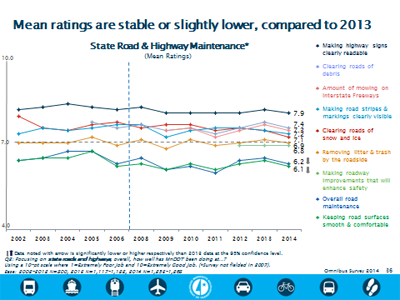
One of the core areas in the Omnibus public opinion survey is maintenance. The survey is MnDOT’s single most reliable source for understanding Minnesotans’ experience of the transportation system. Graphic courtesy of Office of Customer Relations |
The 2014 Omnibus public opinion survey shows that trust and confidence in MnDOT remain high among the majority of the population, but that Minnesotans statewide are experiencing the deterioration of roads and support greater investment in infrastructure.
Of the more than 1,200 interviews conducted, 91 percent of respondents agree with the need to significantly increase investment in the transportation system, compared to 85 percent in 2013.
The survey, conducted yearly by the Office of Customer Relations, measures how the traveling public experiences the transportation system. Core questions are compared year to year, such as maintenance work the public regularly experiences and trust and confidence the public has in MnDOT to deliver the transportation system. The survey also asks questions about transit use, bicycling, and bicycle and pedestrian safety. This year’s survey also included questions about MnPASS.
“The survey is MnDOT’s single most reliable source for understanding Minnesotans’ experience of the transportation system,” said Donna Koren, market research director in the Customer Relations Office. “While the public expressed some specific concerns and dissatisfaction, overall, they think MnDOT is doing a good job.”
Highlights of the survey include:
Trust and confidence
- Seventy-five percent of those surveyed agree that MnDOT takes their concerns into consideration when developing plans. Eighty-six percent said MnDOT prioritizes roadway users’ safety.
- The public’s confidence in MnDOT’s ability to design and build roads and bridges held steady in 2014. Since 2009, there has been a consistent 10-point gap between the public’s confidence in MnDOT’s ability to build roads and bridges with its ability to maintain them.
- Confidence in MnDOT’s ability to provide alternative transportation options rose from 51 percent in 2013 to 58 percent in 2014. That marks the highest level in the history of the question being asked in the survey.
- About two-thirds of residents trust MnDOT to be financially responsible, comparable to 2013.
Maintenance and construction
- Maintenance indicators dropped slightly from 2013. Negative reactions to pavement conditions and potholes, in particular, affected the declines. However, all indicator ratings are within two points of each other (between 6 and 8) on a 10-point scale, consistent with previous years. Indicators include snow and ice removal, signage and striping visibility, and debris removal.
- Twin Cities metro residents are more critical of road surface conditions than they were in 2013. Fifty percent of Greater Minnesota residents continue to positively rate MnDOT’s efforts in keeping road surfaces smooth and comfortable.
- Twenty-six percent said the level of construction disruption is “completely unacceptable,” a decrease from 36 percent in 2013.
Communications
- Overall, perceptions of reliability in MnDOT communications remain consistent. This includes project websites, 511, roadway signage and information in media outlets. Awareness of 511 was up in 2014, at 60 percent, compared to 55 percent in 2013. Respondents who reported 511 as “always” being accurate rose by 25 percent since 2013.
Transit
- Sixty-three percent of residents remain consistently “satisfied” with the availability of public transit, with 25 percent indicating they are “very satisfied.” Greater Minnesota residents are less satisfied because of the lack of any transit or no direct or indirect routes to needed locations.
- Most Minnesotans continue to rely on their personal motor vehicles, but Twin Cities metro residents’ primary usage of a personal vehicle significantly decreased in 2014, from 87 percent in 2013 to 81 percent. Residents indicated a shift to bikes, transit and other options as their primary mode.
Bicycling and pedestrian safety
- Perceptions of bike safety are down slightly from the past three years. Residents are most concerned about distracted and aggressive motorists, but more than 75 percent indicated that lack of wide shoulders, physical separation and bike lanes as key to feeling safe. Bike safety perceptions declined among females, in particular, compared to 2013.
- Perceptions of pedestrian safety remain strong and have been trending up since 2008, at a high of 92 percent in 2014.
- Two in 10 Minnesotans are aware of the Safe Routes to School program, but 64 percent support programs that encourage children to walk or bike to school.
Koren said the survey is used to inform decisions on planning, funding and supporting transportation in the state. The survey is also used to inform public education messaging, such as for Safe Routes to School and MnPASS.
“Overall, it’s good for us to know what’s resonating with the public, what they are noticing in the system, and what is important to them,” said Koren. “It’s another way for MnDOT departments to see that their work is noticed and valued by the public.”
See the complete results at http://ihub/customerrelations/marketresearch.html |
 |
|

|
 |
TABLE of CONTENTS
 |
Donated vacation hours sought for four MnDOT employees |

Gene Matthes, District 6 transportation generalist, is eligible for the state vacation donation program. Photo courtesy of District 6 |
Gene Matthes, District 6 transportation generalist; John Gaither, District 3 transportation generalist; Thomas Brown, District 2 transportation generalist; and Dave Schwarting, District 3 principal engineer, are eligible for the state vacation donation program. The benefit allows employees to donate up to 40 hours of vacation per fiscal year for approved recipients who have exhausted their sick and vacation leave due to injury or illness.
Matthes has been with MnDOT in Albert Lea as a transportation generalist in road maintenance for 33 years.
In mid-2014 he was diagnosed with advanced cancer that began in his lungs and has moved to multiple bones. This is a life-threatening, incurable cancer. Due to the associated pain from the cancer as well as side effects from the chemotherapy he is receiving, he is unable to work.
Gaither is a transportation generalist with the District 3 Cambridge Truck Station. He has been a MnDOT employee since May 2012.
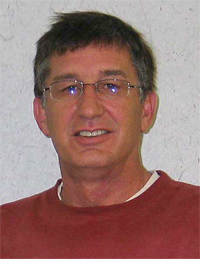
John Gaither, District 3 transportation generalist, is eligible for the state vacation donation program. Photo courtesy of District 3 |
In April 2015, he was diagnosed with stage three cancer, and Gaither is unable to work.
Brown is a transportation generalist in District 2 at the Deer River Truck Station and has more than 26 years of service.
He has been diagnosed with a life-threatening illness.
Schwarting underwent life-threatening heart transplantation Jan. 5 at the University of Minnesota Medical Center after receiving a heart pump (Left Ventricular Assist Device) 2-1/2 years ago.
Employees may donate up to 40 hours of vacation per fiscal year; however, donations in any amount will be helpful. Hours donated are not considered taxable income for the donor nor are they considered tax-deductible expenses.
To donate:
- Log into the State Employee Self-Service website
- Click on “Other Payroll.”
- Click on “Leave donations.”
- Click on “Input Your Leave Donations,”
- Click on the magnifying glass next to “Reserve Bank” to open a list of names.
- Choose the employee’s name you would like to donate to.
- Enter the number of hours that you wish to donate.
- Click on the yellow “Save” box.
A paper form is also available online to donate to an employee on the Vacation Donation Program. |
 |
|

|
 |
TABLE of CONTENTS
 |
From skeptics to believers |
Not everyone was a believer when MnDOT first launched its “Wildly Important Goal” of Enhancing Financial Effectiveness. But as Chief Counsel Betsy Parker soon found out, this wasn’t just another strategic initiative. She and others interviewed in a new video produced by Video Services share how their office’s WIG-supporting efforts have led to permanent change. The short film was shown June 4 at the MnDOT manager’s conference and also includes Ombudsman Deb Ledvina and Metro District South Area Manager Jon Solberg. Video produced by Joel Wenz, Video Services |
|
 |
|

|
 |
TABLE of CONTENTS
 |
Microsoft Lync to become agency videoconference standard July 31 |
By Greg Ruhland
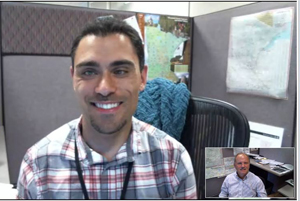
New equipment will be installed in all MnDOT videoconference rooms that enables the use of Microsoft Lync for videoconference meetings. Communications office employees Greg Ruhland (foreground) and Rich Kemp demonstrate the Lync videoconferencing technology. |
For years, MnDOT videoconference meetings have connected staff in separate locations, often in a room with a camera, SMART Board and projection equipment. This July, those capabilities will expand when MN.IT @ DOT staff replaces the original equipment in all MnDOT videoconference rooms with a new technology that enables the use of Microsoft Lync. As a result, videoconference meetings should become easier to host, moderate and share, according to Joe Sass, technology investment coordinator, Corporate Services Division.
Why the further investment in Lync?
In 2013, MN.IT @ DOT introduced Microsoft Lync as a way to connect staff through instant messaging, desktop sharing and virtual conferencing. Today, most employees are familiar with Lync. It gives any state colleague access to instant communication anywhere. Expanding the use of Lync for videoconferencing provides additional benefits, including:
- Eliminating separate videoconferencing fees and replacement costs—saving the agency more than $10,000 each month
- Supporting the state’s goal to reduce travel costs by diminishing the need to attend meetings in-person
- Giving all employees more videoconferencing flexibility. Anyone can schedule and attend meetings from anywhere – in a room, at a desk, even remotely.
Sass said costs will not be transferred to offices or districts; this initiative is funded by the Corporate Services Division.
What’s happening and when?
In the first week of July, new videoconferencing equipment will be shipped to 32 rooms across the state, including Arden Hills, St. Cloud and MnROAD. This equipment consists of a wall-mounted video camera system with remote, two tabletop microphones, an audio mixer/microphone interface and a wireless keyboard and mouse.
From July 6 to July 24, MN.IT @ DOT staff will install the equipment, after which testing and training will occur.
On Friday, July 31, MnDOT will switch over to the new equipment and disable the existing equipment.
Will new videoconference training be offered?
Yes. Watch for future emails and Newsline articles to keep on top of several MN.IT @ DOT training opportunities. In-person or virtual sessions will provide an overview of the new equipment and how to use it to schedule and run meetings using Lync. For users unable to join these synchronous sessions, a variety of Lync training videos and How To documents also are available on iHUB to watch at your convenience. Reference materials will be posted in the conference rooms.
If you have further questions about this project, contact Joe.Sass@state.mn.us. |
 |
|

|
 |
TABLE of CONTENTS
 |
What’s new on the web |
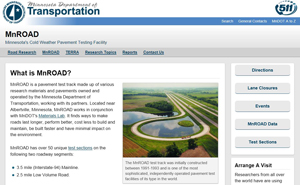
Road Research has a redesigned website that includes information about MnROAD. |
Updated Road Research website
Road Research, including MnROAD, the state’s cold weather road research facility, has redesigned its website using the latest mobile friendly web templates that meet accessibility requirements. In addition to a fresh look, the site is easier to navigate and features online tools to view long-term performance on the MnROAD test cells. The new website also highlights MnROAD’s recent partnership with the National Center for Asphalt Technologies and monthly research pays off online seminars. Road research topic pages are under development to allow quick access to information on a number of subject areas. Check out the new site at www.mndot.gov/mnroad.
Policy updates
Here are the latest updates to MnDOT’s policies:
Find them on A to Z under “P” for policy. |
 |
|
| |
|



